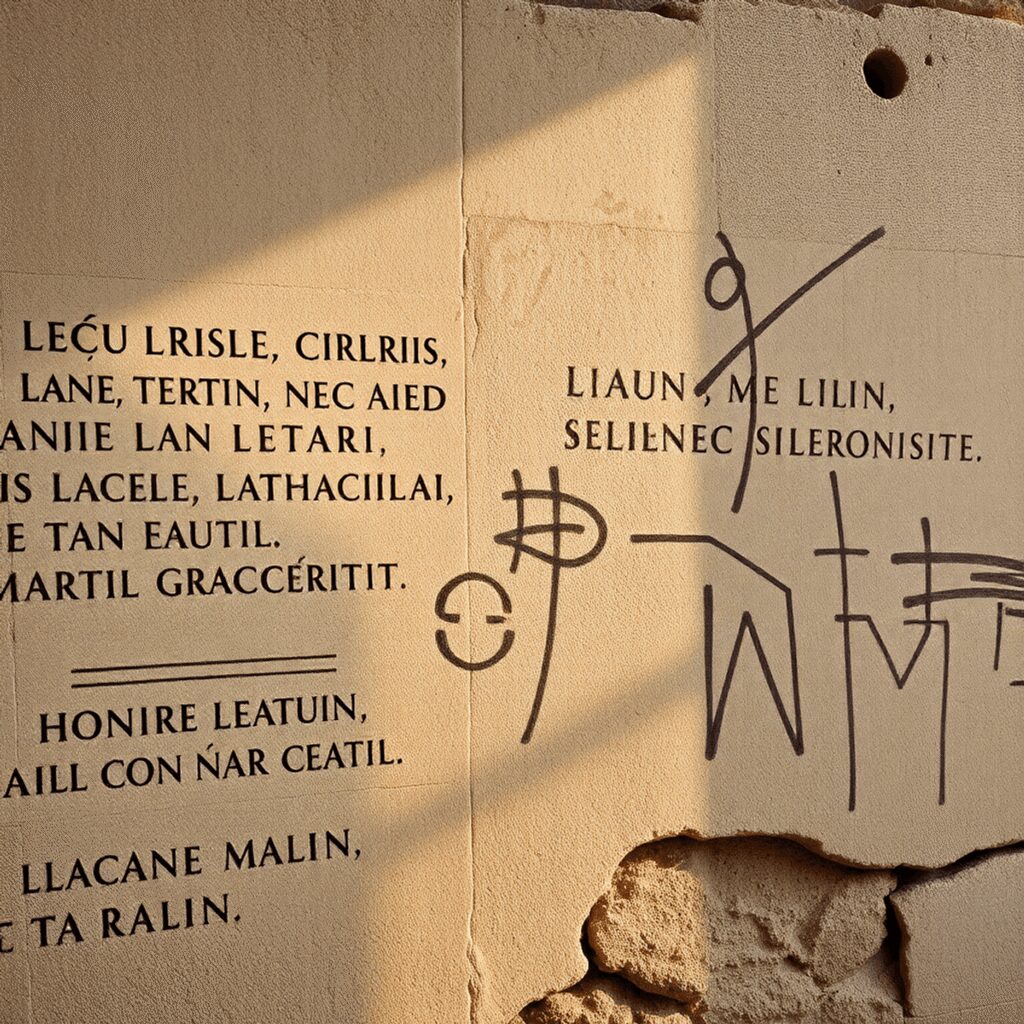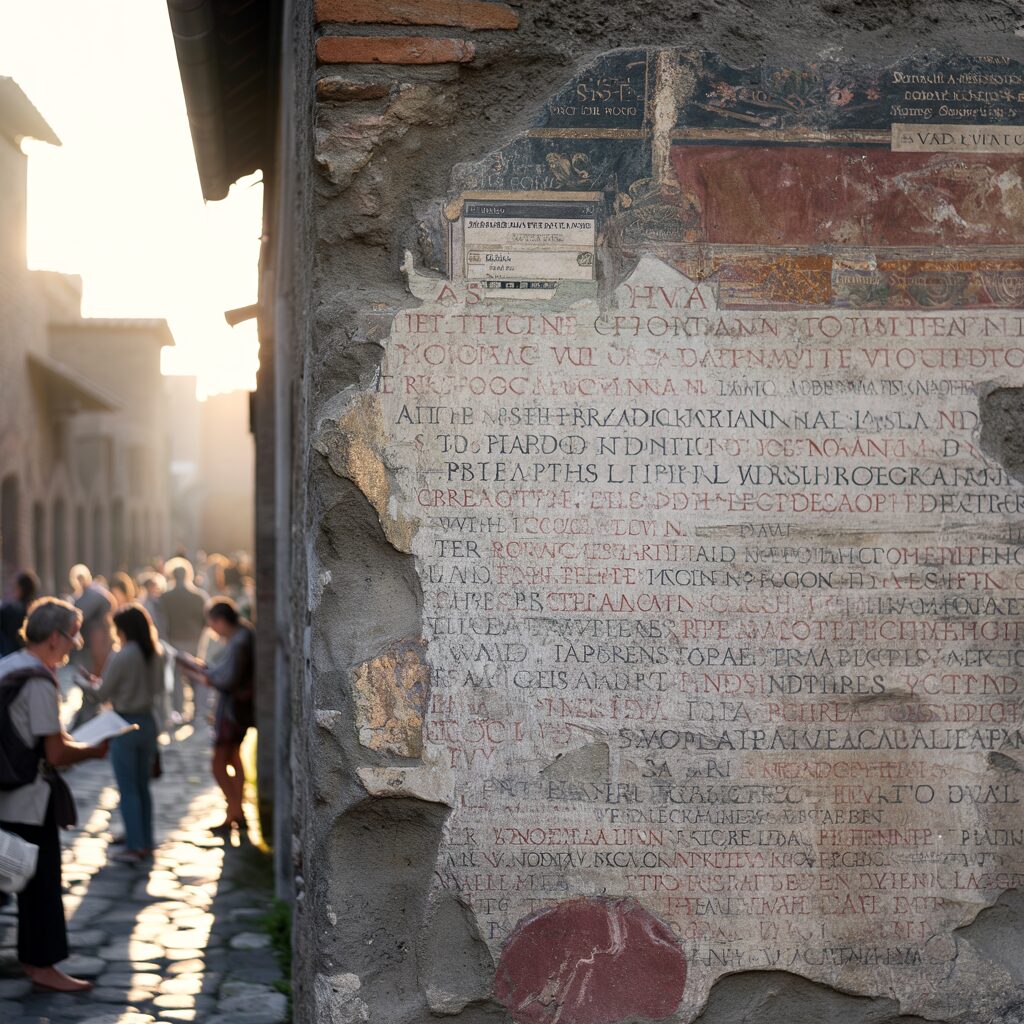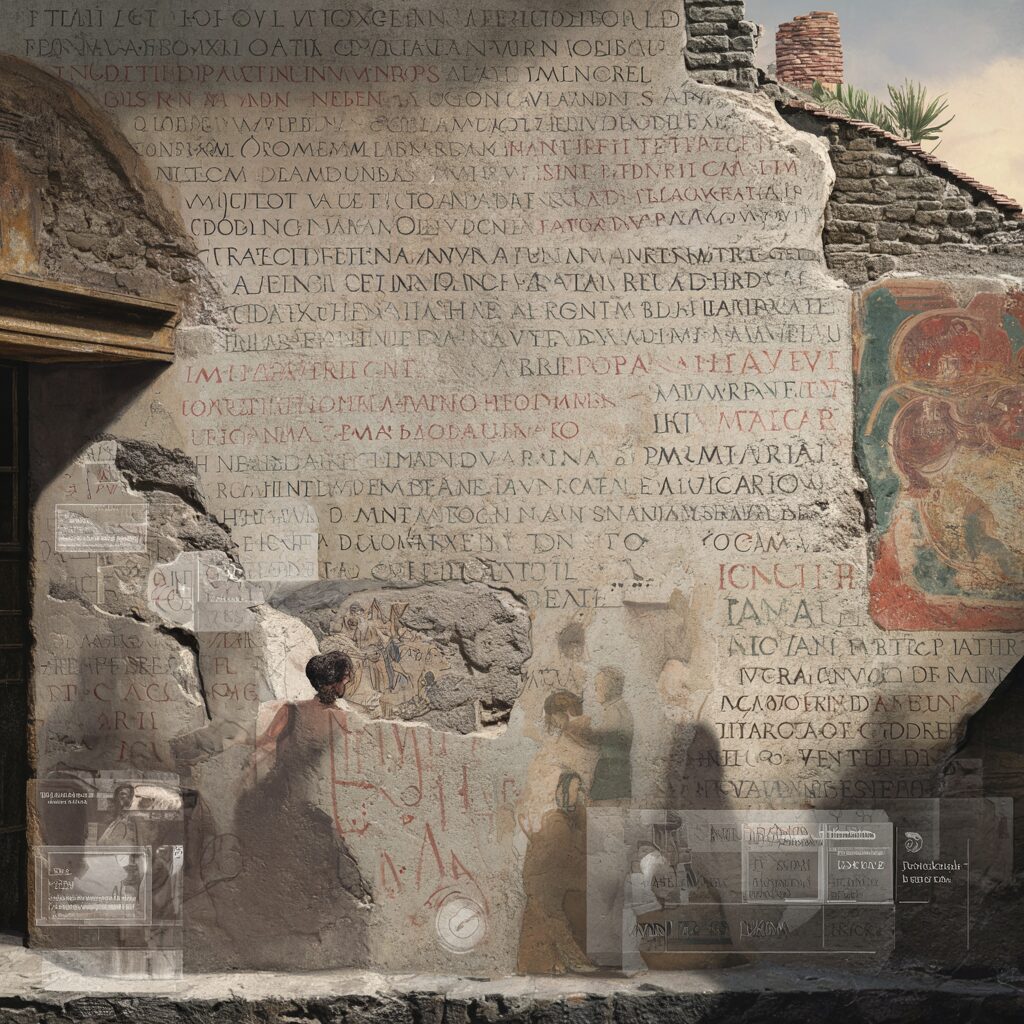Decoding Ancient Roman Graffiti: Voices from the Streets of Pompeii reveals a remarkable facet of ancient life through the informal writings left behind by Pompeii’s residents. Ancient Roman graffiti, scattered across walls, doorways, and public spaces, captures spontaneous expressions ranging from personal messages to political slogans. These inscriptions offer more than mere marks; they serve as vital cultural expressions that provide historians with firsthand insights into everyday experiences.
Pompeii stands out due to its extraordinary preservation after the eruption of Mount Vesuvius in 79 AD, leaving over 11,000 graffiti examples intact. This extensive collection acts as a historical record documenting social interactions, humor, desires, and conflicts of ordinary people rather than elite narratives found in official texts.
Pompeian graffiti offers a unique glimpse into the lives and thoughts of ordinary people in ancient Rome, making it an invaluable resource for understanding the human side of antiquity.
The Rich Diversity of Pompeian Graffiti
The ancient city of Pompeii is a treasure trove of diverse graffiti that offers insights into social interactions, cultural expressions, and literary quotes from the past. Here are some key points to consider:
1. Different Types of Graffiti
Pompeii’s walls are adorned with a rich variety of inscriptions ranging from simple name tags and greetings to profound literary quotes. These writings reflect the daily lives and thoughts of ordinary Pompeians, showcasing their creativity and individuality through these spontaneous expressions.
2. Comparison to Modern Perceptions
Unlike modern perceptions of graffiti as mere vandalism or defacement, ancient Pompeian graffiti was an integral part of social communication and self-expression. These inscriptions were not only tolerated but embraced as a means for individuals to leave their mark on the city’s walls and contribute to the communal tapestry of voices.
By exploring the diverse forms of graffiti found in Pompeii, we gain a deeper understanding of the vibrant culture and society that thrived in this ancient city. The juxtaposition of personal messages, literary excerpts, and everyday observations creates a mosaic of voices that transcends time, bridging the gap between past and present in a truly immersive way.

Insights into Daily Life and Social Dynamics
Graffiti in Pompeii served as an important means of community communication and self-expression. These inscriptions provide insights into how individuals interacted with their environment and with one another, forming a intricate network of social exchanges directly inscribed onto the city’s walls.
Communication beyond formal channels
Unlike official documents or public speeches, graffiti offered an informal, spontaneous way for people to share opinions, jokes, political views, and personal messages. It was a grassroots medium that allowed anyone—regardless of social status—to participate in public discourse. For example:
- A baker might advertise his goods alongside witty remarks about rivals.
- Citizens exchanged greetings or playful insults in taverns or marketplaces.
- Political slogans and endorsements appeared near public buildings during election seasons.
Integration into social patterns
The inscriptions were not random acts of vandalism but part of established social behavior. Walls became interactive spaces where messages built upon one another or responded to previous writings. This feedback loop created a dynamic conversation across time and space within the community. Graffiti served as social markers:
- Declaring friendships or rivalries.
- Announcing events like gladiator games or festivals.
- Commenting on daily happenings, such as weather or food quality.
Impact on community dynamics
Graffiti helped shape identity and belonging within Pompeii’s neighborhoods. Writing on walls allowed individuals to assert their presence in public life, bridging gaps between classes and ages. The visibility of these messages fostered a sense of connection or competition among residents:
“Gaius Pumidius Dipilus was here.” — a simple tag that affirmed personal existence amid bustling urban life.
In this way, graffiti reflected the rhythms of everyday life while influencing social relations, making Pompeii’s streets a living archive of human interaction and cultural expression.

Role of Graffiti in Public Spaces
Pompeii’s public spaces such as theaters and brothels were vibrant canvases for graffiti, reflecting the social pulse of the city. These locations reveal how inscriptions functioned not only as personal expressions but also as interactive dialogues among visitors.
Theaters: A Stage for Wit and Critique
At the theater, graffiti often included witty remarks, political opinions, or critiques of performances. Some inscriptions directly responded to others, creating a dynamic conversation etched into the stone walls. This interaction highlights how public gatherings fostered communal engagement beyond just attending events.
Brothels: Intimate Messages and Social Insights
In brothels, graffiti took on a more intimate and explicit tone. Messages ranged from declarations of love and admiration to humorous or crude comments about specific prostitutes or clients. These writings offer a rare window into the private lives and social interactions within these spaces, revealing attitudes toward sexuality and relationships that are absent from official records.
A Cross-Section of Society
Different social classes left their mark in these public arenas. Evidence shows that graffiti was not restricted to any one group:
- Elites used inscriptions in theaters to showcase wit or political support.
- Lower-class citizens engaged freely in brothel graffiti, expressing desires or boasting achievements.
- Freedmen and slaves also participated, sometimes using graffiti to assert identity or claim social presence.
This cross-section of society contributing to the same walls dismantles assumptions about literacy and access in ancient Rome. The graffiti culture in Pompeii’s public spaces demonstrates how writing served as a democratic tool for communication, blurring social boundaries while amplifying diverse voices.
Decoding Ancient Roman Graffiti: Voices from the Streets of Pompeii reveals that public venues were more than physical gathering spots; they were stages for everyday people to express themselves openly through written words.

Female Participation in Graffiti Culture
Ancient Pompeii challenges traditional ideas about women’s literacy and involvement in public discourse, as evidenced by their active participation in graffiti culture. While historians often assumed that women were not educated or engaged intellectually, the inscriptions found in Pompeii tell a different story, revealing the varied voices of women in ancient Roman society.
Challenging Assumptions about Female Literacy
The presence of female-authored inscriptions suggests a level of literacy and independence that may have been underestimated in historical accounts. This involvement in creating graffiti goes against stereotypes about women’s roles and abilities in ancient times. By actively contributing to public discussions through graffiti, women asserted their presence and influence in the social fabric of Pompeii, a phenomenon that reflects broader trends in women and gender in the ancient world.
Analysis of Content and Tone
The content and tone of female-authored inscriptions offer valuable insights into the thoughts, emotions, and experiences of women in ancient Rome. From love messages to expressions of everyday concerns, these writings reflect a range of themes that resonate with universal aspects of human life. The nuanced perspectives conveyed through these inscriptions add depth to our understanding of gender dynamics and social interactions in Pompeii. Such analysis also aligns with broader academic explorations into the role of women in ancient societies, providing a comprehensive view that recognizes the diverse contributions and perspectives of its female inhabitants.
By exploring the role of women in graffiti culture, we gain a more nuanced understanding of ancient Roman society. These writings not only challenge existing assumptions about female literacy but also serve as a testament to the resilience and creativity of women during this period. They assert that women’s voices were indeed present and influential in shaping the social landscape of Pompeii, an assertion supported by research on women’s roles in ancient Rome.

Digital Projects and Research Insights
Ancient Roman graffiti found in Pompeii has become a focal point for digital cataloging projects, changing the way researchers study and understand these historical inscriptions. With the help of advanced technology and digital tools, scholars can now document, analyze, and preserve these ancient writings for future generations.
Evolution of studying Pompeian graffiti through digital projects
- Digital Cataloging: Various initiatives have digitized and categorized the vast collection of Pompeian graffiti, allowing for easier access and analysis by researchers worldwide.
- Enhanced Preservation: Digital projects ensure the preservation of fragile inscriptions that may be susceptible to deterioration over time, safeguarding this invaluable cultural heritage.
Contributions to understanding literacy rates, cultural practices, and everyday life in ancient Rome
- Insights into Literacy: By studying the content and style of graffiti across different social strata, researchers can glean insights into the literacy rates and educational practices of ancient Romans.
- Cultural Practices: Digital analysis helps uncover cultural norms, beliefs, and societal behaviors embedded within the graffiti, shedding light on everyday life in Pompeii.
- Social Dynamics: Through digital research, scholars can unravel the social interactions, power dynamics, and community structures reflected in these inscriptions, providing a nuanced understanding of ancient Roman society.
These digital initiatives not only facilitate scholarly research but also engage a broader audience in exploring the rich history preserved in Pompeian graffiti. By leveraging technology to decode these ancient voices from the streets of Pompeii, we continue to unravel the complexities of daily life in one of history’s most intriguing civilizations.
Conclusion
Graffiti has a unique way of bringing history to life by giving a voice to everyday individuals. It serves as a reminder that behind every great civilization, there were people with their own stories, struggles, and triumphs.
If you’re intrigued by the world of ancient Rome and want to delve deeper into its captivating culture, I encourage you to explore its inscriptions further. These markings hold valuable insights into the lives of its inhabitants and offer a glimpse into a society that shaped our present.

